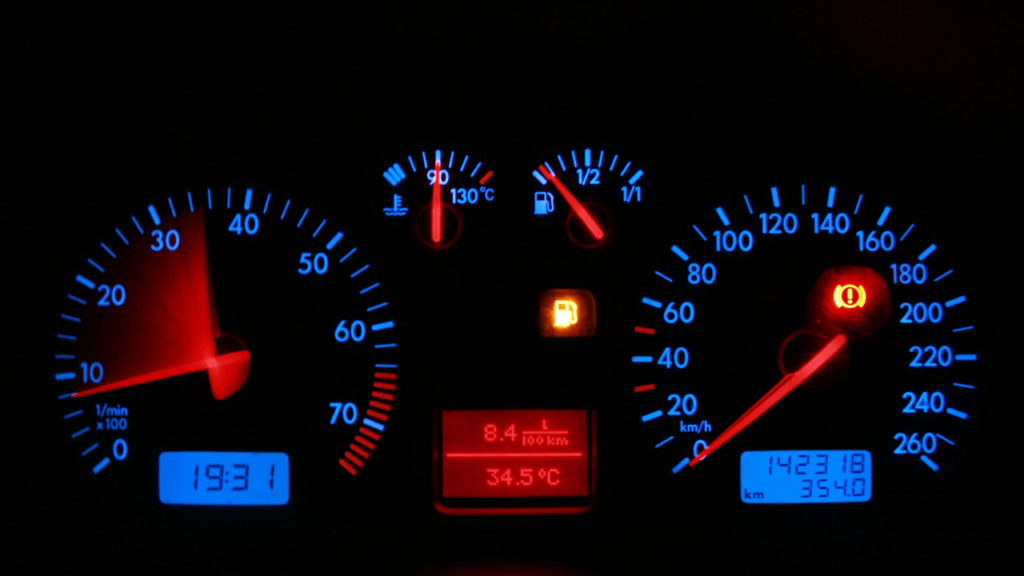Dash lights flickering and no clunking noise of your Jeep’s engine is a common issue with Wranglers but don’t worry, this one is not that serious. The underlying reasons behind the dead engine and crazy dash lights possibly are a weak battery, bad ground connection, and some other issues.
However, if you are dealing with a single clunking noise of your engine and dash lights going out, this article will help you still as I have compiled all the major reasons and, cherry on top; I have given you the simplest solutions too.
So, let’s dive right into the query.
Jeep Wrangler dash lights Going Crazy – Causes and Solutions

Here are a few reasons that may lead you toward a dead battery and flickering dash lights.
1. Loose battery terminals
Loose terminals of the battery are a common cause of flickering lights and a dead engine. Battery terminals often fall weak due to a bumpy ride or driving on rough terrain. They loosely hang from the ports, causing the dash lights to flicker.
You can check it by opening the hood and moving the terminal back and forth; if it comes out quickly, it is why Jeep lights flash on and off.
HOW TO FIX:
Take the loose end and join it with the terminal tightly. If you cannot do it, wind the wires twice or thrice so it helps start the engine temporarily. You can take your Jeep to the mechanic once you have reached home.
2. Bad ground connection
A ground connection is where the negative terminal of the battery is connected to the chassis of the Wrangler. The ground connection helps in case of any high voltage incident, where it passes all the extra current and protects an interference of humans or objects from electrocution.
In Wrangler, sometimes it becomes nearly impossible to ground the electric circuit due to rubber insulation. To encounter this, an external rubber strap connects the engine and chassis. Sometimes this connection becomes loose or corroded, leading to flickering lights.
HOW TO FIX:
Inspect the condition of the ground connection (battery to body and body to battery). Check for both the engine and chassis terminals. Observe any corrosion or rust. If you find any signs, clean the wire with the help of sandpaper.
3. Poor battery connections
Corroded or rusted terminals is one of the common causes of flickering Jeep lights and lifeless engine. It happens when the battery acid interacts with the terminal metal and oxidizes, resulting in corrosion. Corrosion leads to impaired voltage transmission between the battery terminals. Moreover, with this low-level voltage transmission, your Jeep Wrangler dash light may stay on, but the engine dies or gives a single clunking noise.
HOW TO FIX:
Inspect the battery terminals in case of these symptoms by removing the plastic cover. If there is any orange deposition or silver-green deposits without any further crack on the terminals or battery body, clean the terminals and don’t consider replacing the battery.
Rapid cleaning:
Take hot bubbling water and pour it on the corroded terminals. Deposits will melt down. Do this trick on one terminal at a time, and don’t let the water puddle up on the terminal, as it might lead to a short circuit.
This is a simple trick; you can get rid of the toughest corrosion within a minute through this hack.
Deep cleaning:
Take a plier and remove the terminals of the battery. First, unplug the black cable, i.e., negative terminal, and then undo the red cable, i.e., positive terminal. Only touch the terminals with your metal tool at a time. Also, ensure you have turned off your Jeep Wrangler engine while doing it.
Now clean both terminals with the help of a sandpaper or alcohol solution. Replace them after cleaning in reverse order, positive first, then negative.
This simple cleaning process can be performed without any deep electrical knowledge.
4. Faulty ignition switch
The ignition switch is responsible for powering up all the electrical components in the Jeep Wrangler as it ignites the car engine by connecting the battery with a spark plug. If it is not working correctly, you might face issues like a dead motor or dash lights flickering, resulting in voltage loss due to heat and vibrations. Generally, the ignition switch wears out if the Jeep grows old or has traveled vast miles.
HOW TO FIX:
If the ignition switch is caught up with dust and debris, try using a rust remover and apply it with a pressure nozzle through a keyhole. If this trick doesn’t work, you must replace the ignition switch.
5. Dead battery
The battery has a lifespan of two years. After this, it displays low voltage or dead battery signs causing the engine to remain lifeless. Furthermore, a low-voltage battery sometimes causes flickering lights or no light issues, as the dash lights require a minute voltage. Therefore, in both scenarios, you need to check your battery first with the help of a multimeter; if the voltage is less than the range of 12.2 to 12.6 volts, then it is an indication that your battery is not charging completely.
HOW TO FIX:
There is no other option except to replace the battery.
How to jump-start Jeep Wrangler?
If you think your dead engine or flickering dash lights cause the dead battery, you can go for the jump start option.
Steps to follow:
- Put off the engines of the donor battery and receiver battery.
- Connect one end of the red cable to the dead battery’s positive terminal in the Jeep Wrangler.
- Connect the other end of the red cable to the donor battery.
- Connect the black cable to the negative terminal of the donor battery.
- Finally, connect the other end of the black cable to some unpainted/uninsulated metal part of your Jeep Wrangler or directly to the engine.
- Ignite your engine.
- Remove the cables in reverse order.
Safety warnings:
- Please don’t connect the negative terminal directly to the Wrangler battery, as it could cause serious flammable gasses.
- Keep the donor battery engine off, which could result in burning the alternator or other electrical equipment.
Wrap up:
There are many reasons for flickering dash lights and dead Wrangler engine. While looking for the reasons, you must start with the possible causes, like a dead battery, corroded terminals, or faulty ground connection. Moreover, if you are not a mechanically inclined person, do seek professional expertise in the case of an ignition switch changeover or other tedious replacement is required.
Till next time have a safe drive!

Hey there, My name is Joe Martin & I’m the author of OffroadersGuild.com. I’ve been hitting the dirt for a while now. I’ve been off-roading in all sorts of vehicles, from Jeeps to trucks and everything in between.
I’ve also built and modified a few off-road vehicles of my own, so I know what works and what doesn’t when it comes to upgrading and modifying off-road vehicles. I started this website to share my experience and help others get the most out of their off-roading adventures. Let’s hit the trails!

